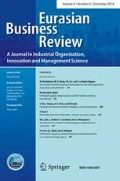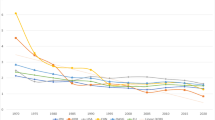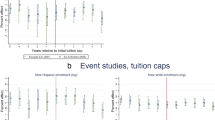Abstract
In this paper, we compare the efficiency of the Italian and German universities in the process of transforming public funding into the multiple outputs of a university, i.e. graduating students, publishing research, and patenting activity. We do this with a particular focus on the policies implemented following the financial crisis in 2008. Using a sample of 133 public universities, of which 73 public universities in Germany and 60 public universities in Italy observed over the period 2006–2011 we find that Italian universities perform significantly better in terms of output maximization than German universities. The crisis does not show a general impact, while the treatment effect indicates that Italian universities coped better during the crisis than their German counterparts at a highly significant level.

Source Own calculations using MaxDEA
Similar content being viewed by others
Notes
German federal and state governments launched the Excellence Initiative in 2005 to support outstanding research and to enable selected universities competing worldwide.
References
Abbott, M., & Doucouliagos, C. (2003). The efficiency of Australian universities: A data envelopment analysis. Economics of Education Review, 22(1), 89–97.
Acs, Z. J., Anselin, L., & Varga, A. (2002). Patents and innovation counts as measures of regional production of new knowledge. Research Policy, 31(7), 1069–1085.
Afonso, A., & Santos, M. (2005). Students and teachers: A DEA approach to the relative efficiency of portuguese public universities. ISEG-UTL Economics Working Paper (07).
Agasisti, T. (2009). Market forces and competition in university systems: Theoretical reflections and empirical evidence from Italy. International Review of Applied Economics, 23(4), 463–483.
Agasisti, T., Catalano, G., Landoni, P., & Verganti, R. (2012). Evaluating the performance of academic departments: An analysis of research-related output efficiency. Research Evaluation, 21(1), 2–14.
Agasisti, T., & Haelermans, C. (2016). Comparing efficiency of public universities among European countries: Different incentives lead to different performances. Higher Education Quarterly, 70(1), 81–104.
Agasisti, T., & Johnes, G. (2009). Beyond frontiers: Comparing the efficiency of higher education decision-making units across more than one country. Education Economics, 17(1), 59–79.
Agasisti, T., & Pérez-Esparrells, C. (2010). Comparing efficiency in a cross-country perspective: The case of Italian and Spanish state universities. Higher Education, 59(1), 85–103.
Agasisti, T., & Pohl, C. (2012). Comparing German and Italian public universities: Convergence or divergence in the higher education landscape? Managerial and Decision Economics, 33(2), 71–85.
Agrawal, A., & Cooper, T. (2015). Insider trading before accounting scandals. Journal of Corporate Finance, 34, 169–190.
Ahn, T., & Seiford, L. M. (1993). Sensitivity of DEA to models and variable sets in a hypothesis test setting: The efficiency of university operations. In Y. Ijiri (Ed.), Creative and innovative approaches to the science of management (pp. 191–208). New York: Quorum Books.
Angrist, J. D., & Pischke, J.-S. (2014). Mastering metrics: The path from cause to effect. Princeton/Oxford: Princeton University Press.
Arcelsus, F., & Coleman, D. (1997). An efficiency review of university departments. International Journal of Systems Science, 28(7), 721–729.
Athanassopoulos, A. D., & Shale, E. (1997). Assessing the comparative efficiency of higher education institutions in the UK by the means of data envelopment analysis. Education Economics, 5(2), 117–134.
Audretsch, D. B., & Lehmann, E. E. (2005). Do University policies make a difference? Research Policy, 34(3), 343–347.
Audretsch, D. B., & Lehmann, E. E. (2016). The seven secrets of Germany: Economic resilience in an era of global turbulence. Oxford: Oxford University Press.
Audretsch, D. B., Lehmann, E. E., & Paleari, S. (2014). Academic policy and entrepreneurship: a European perspective. The Journal of Technology Transfer, 40(3), 363–368.
Autor, D. H. (2003). Outsourcing at will: The contribution of unjust dismissal doctrine to the growth of employment outsourcing. Journal of Labor Economics, 21(1), 1–42.
Beasley, J. E. (1990). Comparing university departments. Omega, 18(2), 171–183.
Besley, T., & Coate, S. (2000). Centralized versus Decentralized Provision of Local Public Goods: A Political Economy Analysis. NBER Working Paper Series, 7084.
Bogetoft, P., & Otto, L. (2010). Benchmarking with Dea, Sfa, and R. New York: Springer Science & Business Media.
Bonaccorsi, A., Daraio, C., & Simar, L. (2006). Advanced indicators of productivity of universities. An application of robust nonparametric methods to Italian data. Scientometrics, 66(2), 389–410.
Bozio, A., Emmerson, C., Peichl, A., & Tetlow, G. (2015). European public finances and the great recession: France, Germany, Ireland, Italy, Spain and the United Kingdom compared. Fiscal Studies, 36(4), 405–430.
Brown, J. R., Dimmock, S. G., Kang, J.-K., & Weisbenner, S. J. (2014). How university endowments respond to financial market shocks: Evidence and implications. The American Economic Review, 104(3), 931–962.
Caldera, A., & Debande, O. (2010). Performance of Spanish universities in technology transfer: An empirical analysis. Research Policy, 39(9), 1160–1173.
Cameron, A. C., & Trivedi, P. K. (2009). Microeconometrics using stata. College Station: Stata press.
Cattaneo, M., Meoli, M., & Signori, A. (2016). Performance-based funding and university research productivity: The moderating effect of university legitimacy. The Journal of Technology Transfer, 41(1), 85–104.
Charnes, A., Cooper, W. W., & Rhodes, E. (1978). Measuring the efficiency of decision making units. European Journal of Operational Research, 2(6), 429–444.
Chu Ng, Y., & Li, S. K. (2000). Measuring the research performance of Chinese higher education institutions: an application of data envelopment analysis. Education Economics, 8(2), 139–156.
Cooper, W. W., Seiford, L. M., & Tone, K. (2006). Introduction to data envelopment analysis and its uses: With DEA-solver software and references. Berlin: Springer Science & Business Media.
der Smitten, S. I., & Jaeger, M. (2012). Ziel-und Leistungsvereinbarungen als Instrument der Hochschulfinanzierung. Hannover: HIS Hochschul-Informations-System GmbH.
Duygun, M., Prior, D., Shaban, M., & Tortosa-Ausina, E. (2016). Disentangling the European airlines efficiency puzzle: A network data envelopment analysis approach. Omega, 60(1), 2–14.
Emrouznejad, A., Parker, B. R., & Tavares, G. (2008). Evaluation of research in efficiency and productivity: A survey and analysis of the first 30 years of scholarly literature in DEA. Socio-Economic Planning Sciences, 42(3), 151–157.
Erkens, D. H., Hung, M., & Matos, P. (2012). Corporate governance in the 2007–2008 financial crisis: Evidence from financial institutions worldwide. Journal of Corporate Finance, 18(2), 389–411.
Etzkowitz, H., & Leydesdorff, L. (2000). The dynamics of innovation: from national systems and “mode 2” to a triple helix of university–industry–government relations. Research Policy, 29(2), 109–123.
European University Association (2012). EUA’s public funding observatory June 2012. http://www.eua.be/Libraries/governance-autonomy-funding/June_2012_report_FINAL.pdf?sfvrsn=0. Accessed 22 Feb 2017.
European University Association (2016). EUA’s monitoring of the impact of the economic crisis on public funding for universities in Europe. http://www.eua.be/activities-services/projects/eua-online-tools/public-funding-observatory-tool.aspx. Accessed 08 Sept 2016.
Froehlich, A. C. (2016). Does the curricular structure affect doctoral enrolment? Journal of Business Economics, 86(9), 1–23.
Gawellek, B., & Sunder, M. (2016). The German excellence initiative and efficiency change among universities, 2001–2011. Working Paper, Universität Leipzig, Wirtschaftswissenschaftliche Fakultät.
Johnes, J. (2006a). Data envelopment analysis and its application to the measurement of efficiency in higher education. Economics of Education Review, 25(3), 273–288.
Johnes, J. (2006b). Measuring teaching efficiency in higher education: An application of data envelopment analysis to economics graduates from UK Universities 1993. European Journal of Operational Research, 174(1), 443–456.
Johnes, G., & Johnes, J. (1993). Measuring the research performance of UK economics departments: An application of data envelopment analysis. Oxford economic papers, pp. 332–347.
Kempkes, G., & Pohl, C. (2008). Do institutions matter for university cost efficiency? Evidence from Germany. CESifo Economic Studies, 54(2), 177–203.
Kempkes, G., & Pohl, C. (2010). The efficiency of German universities–some evidence from nonparametric and parametric methods. Applied Economics, 42(16), 2063–2079.
Lehmann, E. E., & Menter, M. (2015). University–industry collaboration and regional wealth. The Journal of Technology Transfer, 41(6), 1–24.
Lehmann, E. E., & Seitz, N. (2016). Freedom and innovation: A country and state level analysis. The Journal of Technology Transfer, 1–21. doi:10.1007/s10961-016-9478-3.
Lehmann, E. E., & Warning, S. (2002). Teaching or research? What affects the efficiency of universities. Diskussionsbeiträge: Serie 1, Fachbereich Wirtschaftswissenschaften, Universität Konstanz.
Lehmann, E. E., & Warning, S. (2004). Effizienz von universitäten: Anwendung der data envelopment analyse für britische hochschulen jahrbuch für handlungs-und entscheidungstheorie (pp. 69–93). Berlin: Springer.
Leitner, K.-H., Prikoszovits, J., Schaffhauser-Linzatti, M., Stowasser, R., & Wagner, K. (2007). The impact of size and specialisation on universities’ department performance: A DEA analysis applied to Austrian universities. Higher Education, 53(4), 517–538.
Meoli, M., Paleari, S., & Vismara, S. (2013). Completing the technology transfer process: M & As of science-based IPOs. Small Business Economics, 40(2), 227–248.
Molin, M. D., Turri, M., & Agasisti, T. (2017). New public management reforms in the italian universities: managerial tools, accountability mechanisms or simply compliance? International Journal of Public Administration 40(3), 256–269.
OECD (2016). Education at a glance OECD indicators. http://www.oecd-ilibrary.org/docserver/download/9614011e.pdf?expires=1465979696&id=id&accname=guest&checksum=FA97055454B5ABB281E2101539F14669. Accessed 15 June 2016.
Porter, M. E. (2008). Competitive strategy: Techniques for analyzing industries and competitors. New York: The Free Press.
Rostan, M., & Vaira, M. (2011). Faltering effects of market-oriented reforms on italian higher education public vices, private virtues? (pp. 327–343). Cham: Springer.
Sav, G. T. (2016). Recession and post-recession efficiency and productivity changes in United States public universities: The good, bad, and ugly. Advances in Management and Applied Economics, 6(3), 1–15.
Simar, L., & Wilson, P. W. (1998). Sensitivity analysis of efficiency scores: How to bootstrap in nonparametric frontier models. Management Science, 44(1), 49–61.
Simon, H. A. (1959). Theories of decision-making in economics and behavioral science. The American Economic Review, 49(3), 253–283.
Simon, H. A. (1972). Theories of bounded rationality. Decision and Organization, 1(1), 161–176.
Sueyoshi, T., & Goto, M. (2013). Pitfalls and remedies in DEA applications: how to handle an occurrence of zero in multipliers by strong complementary slackness conditions. Engineering, 5(1), 29–34.
Thompson, R. G., Dharmapala, P., & Thrall, R. M. (1993). Importance for DEA of zeros in data, multipliers, and solutions. Journal of Productivity Analysis, 4(4), 379–390.
Thursby, J. G., & Kemp, S. (2002). Growth and productive efficiency of university intellectual property licensing. Research Policy, 31(1), 109–124.
Thursby, J. G., & Thursby, M. C. (2002). Who is selling the ivory tower? Sources of growth in university licensing. Management Science, 48(1), 90–104.
Toutkoushian, R. K., Porter, S. R., Danielson, C., & Hollis, P. R. (2003). Using publications counts to measure an institution’s research productivity. Research in Higher Education, 44(2), 121–148.
Warning, S. (2004). Performance differences in German higher education: Empirical analysis of strategic groups. Review of Industrial Organization, 24(4), 393–408.
Williamson, O. E. (1973). Markets and hierarchies: some elementary considerations. The American Economic Review, 63(2), 316–325.
Author information
Authors and Affiliations
Corresponding author
Additional information
This project benefitted from presentations at the XVII Annual Scientific Meeting of the Associazizone italiana Ingegneria Gestionale on October 13th and 14th, 2016, as well as at the 4th Workshop on Education in Efficiency in Milan on October 20th and 21st, 2016. In particular, we are grateful to Mattia Cattaneo (University of Bergamo), Cristina Rossi-Lamastra (Technical University of Milan), Tommaso Agasisti (Technical University of Milan) and two anonymous reviewers for their very constructive comments and suggestions. Of course, the authors are responsible for any remaining error. Parts of the project were kindly funded by the competence center for Global Business Management in Augsburg.
Rights and permissions
About this article
Cite this article
Lehmann, E.E., Meoli, M., Paleari, S. et al. Approaching effects of the economic crisis on university efficiency: a comparative study of Germany and Italy. Eurasian Bus Rev 8, 37–54 (2018). https://doi.org/10.1007/s40821-017-0091-7
Received:
Revised:
Accepted:
Published:
Issue Date:
DOI: https://doi.org/10.1007/s40821-017-0091-7




